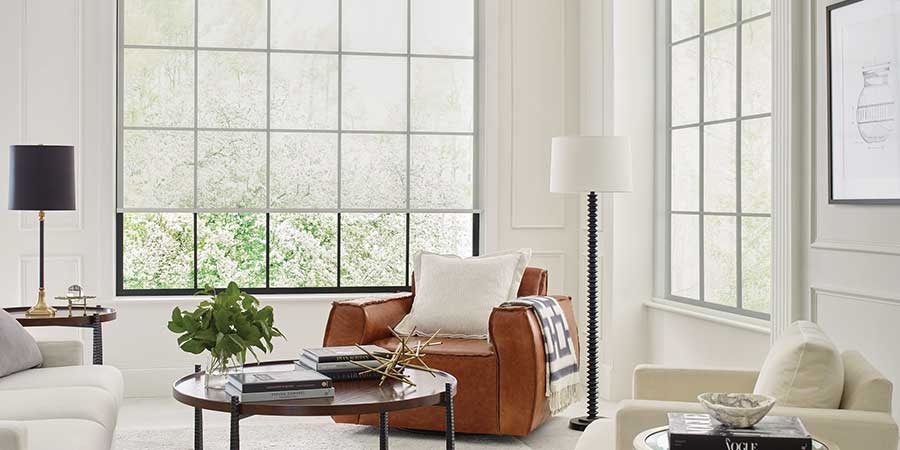As summer draws near, you’ll need a plan to keep your home cool and comfortable. One way is with window treatments. There are many window covering products that will protect your home from the dog days of summer. But, what’s causing the heat gain anyway? Let’s uncover the reasons why you home is so warm, and the best ways to keep your home cool. Energy saving window treatments may help.
Can you Feel the Heat Transfer?
Heat transfer is the reason most homeowners wouldn’t think of leaving windows bare, and it’s what makes your home feel stuffy in the middle of summer. But heat transfer can also be a welcomed effect. It can heat up your breakfast nook, and provide a cozy spot for your morning coffee. Let’s learn more about heat transfer, and more importantly, how to control it. There are 3 types:
Conduction: Heat can be transferred through a solid object. A window heats up on a hot day, and then transfers that heat inside. Insulation to prevent this type of heat transfer is important.
Radiation: Follow a sunbeam from the window to the carpet. The sunbeam might not feel hot, but the spot where it lands is. Heat is not felt in the air, but on the surface. When this happens indoors, there is nowhere for the warm air to go.
Convection: Moving air will bring heat to a cool window on a hot day, and carry heat away from the window on a cold day. Insulation will provide a proper barrier to keep the interior temperature comfortable, not letting exterior air affect the interior air.

Can you Escape Heat Gain?
Heat gain is the result of heat transfer. It’s the exhausting temperatures you feel inside your home, even when it’s closed up with the AC running. It’s the warm countertops from where the sun comes through the windows. Can you escape it? It helps to provide a barrier between the exterior air and the interior air. Window coverings help reduce radiant heat by blocking the sun from shining into the space at all, an effective way to keep your home cool. Above, the photo depicts floor to ceiling windows completely bare. Every surface with sunshine is going to heat up, causing the surrounding air to heat up. The same room–featured below–is made more comfortable just blocking the sunshine.

Our Best Energy Saving Shades
A top choice in energy efficient shades is Honeycomb Shades. Air pockets inside these cellular shades create a barrier, trapping air. This keeps the exterior air from influencing the interior air. When raised, these shades stack tightly at the top of the window.

The same air filled pockets and cellular design is present in Sonnette Cellular Roller Shades. The only difference is the operating system–they roll up and out of sight. These thermal shades offer a great barrier of protection, easily helping you keep your home cool in the summer, but roll up out of the way.

A long-standing energy efficient option for windows is draperies. Today, custom drapes are available, and can be customized, depending on the amount of sunshine your home receives. They can be light and sheer, or feature a liner to provide more protection from the elements.

To reduce heat gain, try Plantation Shutters. They have adjustable louvers that, when closed flat, keep light from entering completely. When sunshine is blocked, there are no surfaces heating up, and you’ll be more prepared to keep your home cool. When the louvers are adjusted in a specific position, light enters, but the direct light doesn’t come into contact with surfaces. Shutters are great at slowing air flow and offer an effective barrier against heat transfer.

Roman Shades can block entering light. When they are lowered, the folds of fabric create shapes that reduce the airflow-keeping warm air out. The air flow can be responsible for raising temperatures in your home during the hot summer months, so reducing it will slow down that effect. Another option is the rolling roman shade to block incoming light. Both can help keep your home cool in the summer.

The reflective quality of Sheer Shades helps to keep interiors cooler. Not only do sheer fabrics diffuse the direct light, but because they reflect sunshine outside, much of the radiant heat transfer can be reduced. The difference between bare windows compared to covered windows is apparent.

Ways to Keep Your Home Cool this Summer
Covering your windows with treatments is a good first step in reducing heat gain due to heat transfer. Window treatments can block the sun, insulate your windows and reduce air flow. Invite our specialists to your home to evaluate the most vulnerable areas in your home. We can then create a plan of action to keep your home cool and comfortable this summer. Make an appointment for a FREE design consult today.




